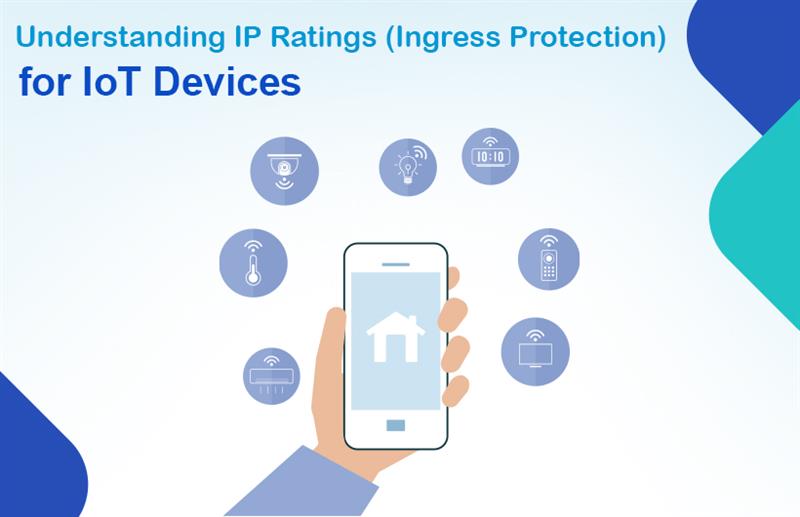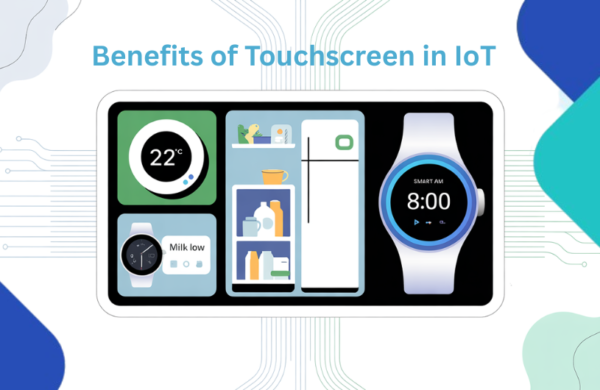As IoT devices continue to evolve and expand into diverse applications—ranging from indoor smart assistants to robust industrial sensors—understanding how well these devices withstand environmental conditions is critical. Embedded hardware with IoT and AI plays a key role in ensuring that these devices can function effectively across various settings. IP ratings, or Ingress Protection codes, define a device’s resistance to dust and moisture, ensuring durability in various environments.
But what is an IP rating in IoT devices, and why does it matter so much?
An IP rating in IoT devices indicates how well the device is protected against dust and water. It matters because it ensures the device can function reliably in different environments, from indoor settings to harsh outdoor or industrial conditions.
What is an IP Rating in IoT Devices?
An IP rating is a standardised system defined by the International Electrotechnical Commission (IEC) that classifies the degree of protection a device’s enclosure provides against the intrusion of solids (like dust) and liquids (like water). These ratings are crucial for IoT devices, which are often deployed in uncontrolled environments where dust, moisture, or water are common risks.
The IP rating is typically expressed in the format IPXY, where:
- The “X” in an IP rating signifies the level of protection against solid objects, ranging from 0 (no protection) to 6 (complete dust resistance).
- Y indicates protection against liquids (scale: 0 to 9K)
For instance, a device with an IP67 rating offers full protection against dust and can safely be submerged in water up to a depth of 1 meter for as long as 30 minutes.
Common IP Ratings for IoT Devices
Here are some widely used IP codes for smart devices and what they mean in practical terms:
IP65: Dust Tight & Water Jet Resistant
- Solid protection: Complete dust protection
- Liquid protection: Protects against low-pressure water jets, ensuring durability.
- Ideal for: Outdoor sensors, security cameras, and smart agricultural tools that may encounter dust and rain.
IP67: Dust Tight & Immersion Proof
- Solid protection: Complete protection against dust
- Liquid protection: Can be submerged in water up to 1 meter for 30 minutes
- Ideal for: Fitness trackers, smartwatches, rugged mobile devices, and outdoor IoT units subject to rain or accidental submersion.
IP68: Extended Immersion Resistance
- Solid protection: Completely dustproof
- Liquid protection: Engineered to endure prolonged submersion in water at depths greater than 1 meter, with specific limits set by the manufacturer.
- Ideal for: Underwater sensors, marine IoT equipment, and swim-friendly wearable devices.
IPX4, IPX5, IPX6: Water Resistance Without Dust Rating
- IPX4: Splash-resistant (e.g., sweat, kitchen splashes)
- IPX5–X6: Resistant to low/high-pressure water jets
Devices with IPX ratings are generally used in environments where liquid exposure is a concern, but dust protection isn’t critical.
Why IP Ratings Matter for IoT Devices
IoT deployments can vary drastically indoor smart hubs, warehouse automation systems, smart agriculture sensors, or connected outdoor lighting. Each setting has different exposure levels to environmental threats. The IP ratings for IoT devices ensure that these devices can function reliably in their specific operating environments.
For example:
- A smart speaker in a living room may only need IP30, offering basic protection against solid objects, but not water.
- A smart irrigation controller installed outdoors should ideally be IP65 or above to resist both dust and heavy rainfall.
- Industrial IoT sensors used in wash-down environments, like food processing plants, may need IP67 or even IP69K, which is designed to resist high-pressure, high-temperature water jets.
IP Ratings by Use Case

What IP Ratings Don’t Cover
While IP ratings are excellent for evaluating a device’s physical resistance, they do not account for:
- Corrosion resistance (e.g., saltwater environments)
- UV exposure from sunlight
- Extreme temperatures (unless paired with thermal testing)
- Pressure or chemical resistance, which are especially relevant in specialised industrial settings
In such cases, additional certifications and material considerations should complement the IP rating.
Designing for an IP Rating
Achieving a high IP rating isn’t just a matter of sealing a device shut. It involves strategic design and rigorous testing. Some engineering considerations include:
- Gaskets and O-rings to seal enclosures
- Sealed cable entries or waterproof connectors
- Venting membranes to allow air exchange while blocking water
- Potting compounds to protect electronics
It’s also essential to test these designs using standardised methods. For example, a dust chamber test for IP6X ratings, or immersion tanks for IPX7/IPX8.
Once a prototype passes, consistent manufacturing practices are crucial to ensure every unit meets the claimed IP standard.
Choosing the Right IP Code for Smart Devices
When selecting or designing an IoT device, always start by identifying the intended environment and expected challenges. From there, match the appropriate IP rating.
For instance:
- A wearable health tracker may need to be IP68 to survive showers or swimming.
- A factory-floor sensor might only require IP65, but also needs vibration resistance.
- A home automation hub might function perfectly at IP40, as it stays indoors.
Conclusion
Understanding IP ratings for IoT devices is essential for ensuring long-term reliability, safety, and customer satisfaction. These ratings help developers and manufacturers design smart devices that withstand the environmental challenges they’re likely to face.
When building or choosing IoT products, take IP ratings seriously. They’re more than just a number; they’re a promise of durability and resilience.
As a leading embedded and IoT software development company, Monarch Innovation focuses on smart product design by helping clients integrate proper enclosure protection tailored to the real-world use of their devices. Whether you’re developing a new consumer gadget or a rugged industrial sensor, planning for IP protection early in the design phase pays off in reliability and performance.
FAQs
1. What does IP rating stand for?
IP rating stands for Ingress Protection rating, which is a standard that indicates how well a device is protected against the intrusion of solid objects and liquids.
2. How is an IP rating structured?
An IP rating typically consists of two digits. The first digit indicates the level of protection against solid objects (ranging from 0 to 6), while the second digit indicates the level of protection against liquids (ranging from 0 to 9).
3. What do the numbers in an IP rating mean?
The numbers in an IP rating convey specific protection levels: for example, an IP67 rating means the device is completely dust-tight (6) and can withstand immersion in water up to 1 meter for 30 minutes (7).





